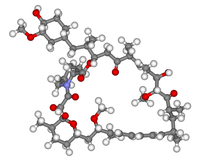
Photo from wikipedia
Precision medicines exert selective pressure on tumor cells that leads to the preferential growth of resistant subpopulations, necessitating the development of next-generation therapies to treat the evolving cancer. The PIK3CA–AKT–mTOR… Click to show full abstract
Precision medicines exert selective pressure on tumor cells that leads to the preferential growth of resistant subpopulations, necessitating the development of next-generation therapies to treat the evolving cancer. The PIK3CA–AKT–mTOR pathway is one of the most commonly activated pathways in human cancers, which has led to the development of small-molecule inhibitors that target various nodes in the pathway. Among these agents, first-generation mTOR inhibitors (rapalogs) have caused responses in “N-of-1” cases, and second-generation mTOR kinase inhibitors (TORKi) are currently in clinical trials. Here we seek to delineate the likely resistance mechanisms to existing mTOR inhibitors in human cell lines, as a guide for next-generation therapies. The mechanism of resistance to the TORKi was unusual in that intrinsic kinase activity of mTOR was increased, rather than a direct active-site mutation interfering with drug binding. Indeed, identical drug-resistant mutations have been also identified in drug-naive patients, suggesting that tumors with activating MTOR mutations will be intrinsically resistant to second-generation mTOR inhibitors. We report the development of a new class of mTOR inhibitors that overcomes resistance to existing first- and second-generation inhibitors. The third-generation mTOR inhibitor exploits the unique juxtaposition of two drug-binding pockets to create a bivalent interaction that allows inhibition of these resistant mutants. Citation Format: Kevan M. Shokat. Third-generation inhibitors of mTOR. [abstract]. In: Proceedings of the AACR Special Conference on Translational Control of Cancer: A New Frontier in Cancer Biology and Therapy; 2016 Oct 27-30; San Francisco, CA. Philadelphia (PA): AACR; Cancer Res 2017;77(6 Suppl):Abstract nr IA25.
Journal Title: Cancer Research
Year Published: 2017
Link to full text (if available)
Share on Social Media: Sign Up to like & get
recommendations!